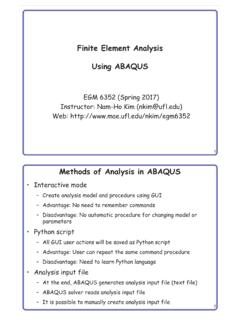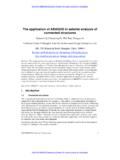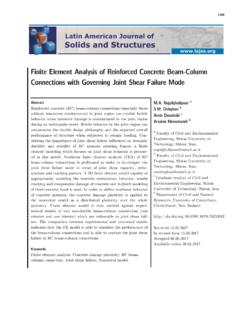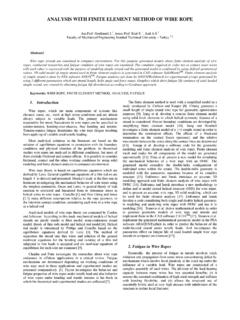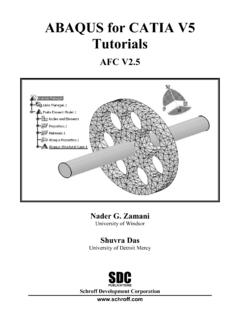Transcription of INFLUENCE OF MISALIGNMENT AND BACKLASH ON SPUR …
1 RW| RESEARCHWORLD Press, International Conference, Kuala Lumpur Malaysia, 18th October 2014, ISBN: 978-93-84209-57-5 31 INFLUENCE OF MISALIGNMENT AND BACKLASH ON spur GEAR using FEM 1 NOUBY M. GHAZALY, 2 ALI A. KAMEL, 1 Mechanical Engineering Dept., Faculty of Engineering, South Valley University, Qena-83523, Egypt 2,3 Production and Design Dept., Faculty of Engineering, Minia University, El-Minia 61111, Egypt E-mail: Abstract- The main objective of this work is to investigate the INFLUENCE of shaft MISALIGNMENT and BACKLASH on the stress generated on the spur gear. Finite element analysis using ABAQUS software is used to determine the stresses and deflections on gear tooth. Three-dimensional finite element model of pinion gear engaged with a solid gear is created. The material is considered homogenous and isotropic with a linear elastic behavior.
2 The gear pair contact position is chosen to determine contact stress assuming small sliding and dry friction contact. Appropriate loading and boundary conditions are considered. Based on the simulation, the INFLUENCE of different values of MISALIGNMENT angle and BACKLASH on equivalent stress is examined. It is observed that the highest MISALIGNMENT angle resulted in the highest generated tooth stresses. Moreover, it can be concluded that the results of this research should be helpful in the design and manufacture of spur gears. Keywords- Finite Element Method, Stress Analysis, MISALIGNMENT , BACKLASH . I. INTRODUCTION Nowadays, progresses in the design and production method of spur gears enable their use in an increasingly wide range of applications.
3 Therefore, there have been many attempts in recent years to understand and describe the process of the meshing of spur gears in order to increase the performance requirements, such as high load capacity, high endurance, low cost, long life, and high speed. In general, the main functions of gear systems are to; reduce the rotational speed, increase the torque applied, change the direction of the power transmissions and distribute the available power between several machines. During the last decades many research works have been directed towards evaluating stress analysis of spur gear to improve the performance requirements. The analysis of stresses generated in gear teeth is considered as a limiting factor for gear designers.
4 Hence according to the analysis of generated stresses, transmitted load, running speed, tooth geometry and other design considerations can be determined. The importance of stress analysis is focused on the determination of stress concentration regions that failure or fracture may initiate at these regions. In general, gears may be designed to operate at a nonstandard center distance to introduce BACKLASH , to accommodate space constraints and to adjust for anticipated deflections under load as well as geometry changes due to thermal effects. Therefore, for good operation, center distance must be held within predetermined tolerances. Since the center distance is a machined dimension, it may not come out be exactly what the design calls for.
5 Moreover, due to mounting inaccuracies, MISALIGNMENT and other faults created during running of gearing system, the desired center distance is practically not possible to accurately reach. Several researches and studies have been done and used different ways for the generated stresses analysis on the movement transmitting gear teeth. Recently, the stress analysis comes to be simulated by FEA for gear design. The capabilities of FE models, with a vast number of degrees of freedom, have enabled the accurate representation of the gear system. The analysis of gear stress analysis using FE model can mirror each detail of the gear design, while this requires a lot of effort to do substantial changes in the geometry of components. Tae H. Chang and A.
6 Kubo studied the stresses distribution in spur gear and analyzed the stresses and deformations in the gear in order to define the expected failure locations. Also for three dimensional modelling, Simon obtained the loads and stresses distributions on the teeth for spur and helical gears. He also derived an empirical expression for tooth deflection and tooth shearing depending on loading position and geometry. The method enables the use of varying tooth stiffness depending on where contact occurs across the line of action. Lewicki and Ballarini examined the stresses distributions on the spur gear using finite element methods. The INFLUENCE of MISALIGNMENT between the rotation axes of the gears as well as shaft centre distance changes on the mesh stiffness was investigated.
7 Also, they reported that the disadvantages of a three dimensional versus a two dimensional model are higher complexity and hardware requirements as well as computation times. In this paper, finite element contact analysis is chosen for modelling and simulation of gear pair using ABAQUS software. The effect of MISALIGNMENT of shaft on the stresses distribution and its concentration on the spur gear is investigated. Also, the BACKLASH clearance on the stresses distribution and its INFLUENCE of MISALIGNMENT and BACKLASH on spur Gear using FEM RW| RESEARCHWORLD Press, International Conference, Kuala Lumpur Malaysia, 18th October 2014, ISBN: 978-93-84209-57-5 32 concentration on the movement transmitted gear teeth are studied. In the following sections the development of the three-dimensional finite element model is described.
8 This involves the fully parametrical creation of the gear shape, the meshing and the simulation process. II. FINITE ELEMENT MODEL Due to the progress of computer technology and the computational techniques, the FEA becomes a popular and powerful analysis tool to determine the formation of bearing contacts and stress distributions of gear drives. Therefore, in the present study, a detailed 3-dimensional FE model of the gear pair is developed to calculate the stress and deflections on gear tooth. The spur gear is designed according to AGMA standard and gear design handbook. The specifications of the spur gear are presented in Table 1. First of all, solid model of the gear geometry consisting of lines and areas using INVENTOR software is created using a very high number of key points, as shown in Figure 1.
9 Next, the solid model is imported to ABAQUS software to further analysis and simulation. The material properties of the pinion and gear are selected as homogenous and isotropic with a linear elastic behavior and listed in Table 2. Then, as the contact between pinion and gear is the most important and critical part of the gear pair simulation, the interaction between the gear pair is chosen to determine contact stresses assuming small sliding and dry friction contact. After that, the gear pair is completely meshed using a mapped meshing. A completely meshed gear pair is shown in Figure 2. The constraints used in the model are as follows: the hub of the gear is completely constrained from motion; the nodes at the hub of the pinion can only rotate around the centre of the pinion.
10 Finally, the solving process is started using quasi-static process and a fully automated post processing is conducted. Table 1 Gear parameters Parameter Assigned value Desired gear ratio Module 2 Center distance 48mm Number of teeth Pinion 19 Gear 29 Face width 23mm Pressure angle 20 Clearance mm Root fillet Table 2 Material properties Property Assigned value Density 7850 kg/m Elasticity modulus 210 GPa Poison ratio Figure 1 solid model of gears Figure 2 Mesh of spur gears III. RESULTS AND DISCUSSIONS The stress distribution obtained from ABAQUS of the modeled gear for various misalignments and BACKLASH for the given loads and boundary conditions are observed. The results reveal that the stress is distributed uniformly but maximum stresses are developed near the root of the bottom gear, as shown in Figure 3.
